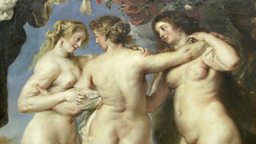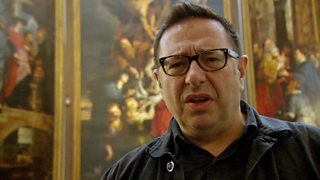Flesh of inspiration: Reassessing Rubens
19 December 2014
In BBC Two documentary Rubens: An Extra Large Story, WALDEMAR JANUSZCZAK sets out to correct the misconceptions that have arisen about the artist, whose vast and grandiose canvases seem too much for modern sensibilities. Here Waldemar writes for BBC Arts about making the show, and presents two exclusive clips on Rubens and his art, along with a gallery of all the works featured.

Making a Rubens film is not for the fainthearted. His art challenges you in many ways. Chief among the problems is the crazy fertility of the man. What a lot of stuff he did.
Among the undisputed greats of art, only Picasso can rival Rubens in the number of works he produced, and the range of media he employed. Tapestries, domestic interiors, altarpieces, portraits, nudes, landscapes, mythologies, all manner of prints and book illustrations - Rubens did everything.

Rubens' women are seen as something unhealthy, lax and even disgusting. It’s a viewpoint I try to challenge
And he wasn’t just an artist. He was also a politician, a landscape designer, an architect. Trying to find a path through all this output is the filmic equivalent of a trek through the Amazon – without a map. Or a compass!
So that’s one problem. But then there are all the other problems! Rubens wasn’t just fertile. He was also fleshy and abundant in a way that the modern world does not generally admire.
Not to mince words – his women are too fat. It’s what everyone knows about him. The phrase ‘a Rubensian woman’ has entered our national conversation. When you call somebody that what you are really saying is "she needs to go on a diet".
Dawn French put it wonderfully: "If I had been around when Rubens was painting, I would have been revered as a fabulous model. Kate Moss? Well, she would have been the paintbrush."
In our world, a world that sends size zero girls onto its catwalks, Rubens' women are seen as something unhealthy, lax and even disgusting. It’s a viewpoint I try to challenge in my film.
Who’s really unhealthy here? The modern world with its starvation diets and its liposuction? Or Rubens’ world with its motherly softnesses and its bigger bottoms? Rubens, reader, is all about the bass. And that makes him more contemporary than many have assumed.
Is that where the problems end: with his larger women? No. It’s where they start. The size of Rubens’ women has a direct correlation with the size of his mythologies. We all like a bit of Greek and Roman mythology, right? But does it really have to come in these immodest pictorial sizes?
There are Rubens paintings out there that are bigger than the side of a house. And look how much exposed and bouncy flesh they contain. Where some painters give us a single Venus reclining alluringly on a bed, Rubens gives us thousands of them, massed into huge mythological armies, biting, fighting, wobbling crazily in our direction.
When you find out what they’re actually doing in these huge expanses of shaking pictorial flesh, you see things that would make Peter Stringfellow blush
And when you turn a camera on them, and find out what they’re actually doing in these huge expanses of shaking pictorial flesh, you see things, reader, that would make Peter Stringfellow blush. When I say that Rubens was inventive I mean it as a compliment, but also as a bit of a warning.
Most of the time he was joyous and exciting. But every now and then he was pictorially outrageous, too. Fortunately, in ways that the camera enjoys discovering.
When I set out to make this film, I had no idea what was really happening in the far corners of his art. Few people have ever got high enough or close enough to see it. But modern cameras can. And, hallelujah, they love it.
Huge mythologies are one thing. Huge bits of over-the-top Catholicism is another. This is no place for a proper discussion about the religious tastes of Britain, but let’s just say that over-the-top Catholicism is not something that finds natural favour on these shores.
The religious art that Rubens produced – big, weeping Madonnas; dramatically expiring Christs – has a succulence to it that feels off-puttingly foreign. So imagine my surprise – it was actually a shock – to find out that Rubens was born a protestant: a Calvinist.
His father was a notorious Calvinist lawyer whose antics got the Rubens family in deep religious trouble when their little boy, Peter Paul, was born in 1577. You’ll have to watch the film to find out exactly what happened between Rubens senior and the louche German princess. Dad’s behaviour was neither legal nor Calvinist. But it did make little Rubens - our Rubens - what he was.
Is that the end of the Rubens problems, then? Is it hell. There is also the very tricky business of collaboration: who did what in a Rubens picture? Didn’t he have a huge studio and didn’t they do all the work?
Well, yes. But also, no. It’s complicated. To understand how Rubens managed to produce as much great art as he did you have to see things differently.
How differently? Well, what you have to do is... damn. Run out of space. That’s another Rubens problem. It’s all in the film.
Exclusive clips
Watch the show
-
![]()
Rubens: An Extra Large Story
The programme aired on BBC Two on Saturday 3 January, and is available on iPlayer for 30 days.
More on Rubens
-
![]()
Did Rubens make big beautiful?
iWonder asks whether Rubens set out to glorify the larger female form
-
![]()
Art UK
Watch a slideshow of 281 paintings by Peter Paul Rubens
External links
Art and Artists: Highlights
-
![]()
Ai Weiwei at the RA
The refugee artist with worldwide status comes to London's Royal Academy
-
![]()
BBC Four Goes Pop!
A week-long celebration of Pop Art across BBC Four, radio and online
-
![]()
Bernat Klein and Kwang Young Chun
Edinburgh’s Dovecot Gallery is hosting two major exhibitions as part of the 2015 Edinburgh Art Festival
-
![]()
Shooting stars: Lost photographs of Audrey Hepburn
An astounding photographic collection by 'Speedy George' Douglas
-
![]()
Meccano for grown-ups: Anthony Caro in Yorkshire
A sculptural mystery tour which takes in several of Britain’s finest galleries
-
![]()
The mysterious world of MC Escher
Just who was the man behind some of the most memorable artworks of the last century?
-
![]()
Crisis, conflict... and coffee
The extraordinary work of award-winning American photojournalist Steve McCurry
-
![]()
Barbara Hepworth: A landscape of her own
A major Tate retrospective of the British sculptor, and the dedicated museums in Yorkshire and Cornwall
Art and Artists
-
![]()
Homepage
The latest art and artist features, news stories, events and more from BBC Arts
-
![]()
A-Z of features
From Ackroyd and Blake to Warhol and Watt. Explore our Art and Artists features.
-
![]()
Video collection
From old Masters to modern art. Find clips of the important artists and their work

















